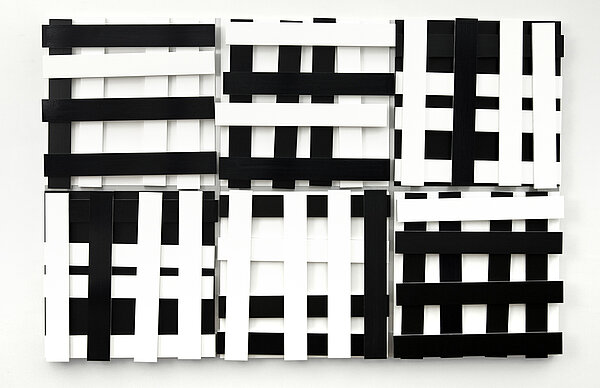Imi Knoebel
Weiß Schwarz 15, 2010
[White Black 15]
Acrylic on aluminium
184 x 277 x 8,7 cm
© VG Bild-Kunst, Bonn 2022
Photo: Gerhard Sauer
Already during his student days under Joseph Beuys at the Düsseldorf academy (from 1965 to 1971), Imi Knoebel undertook a critical appraisal of the underlying factors in painting, which led to him pare down his visual means. This was accompanied by a logical shift in his artistic interests to the materiality of the picture carrier, which he elevated into a pictorial element in its own right.
Together with his friend Rainer Giese, with whom he also appeared from 1962 onward as the artist duo IMI & IMI, in 1965 Knoebel moved into the studio at the Düsseldorf academy next to Room 20, where Beuys ran his class. The shortly to become legendary Room 19 oscillated between workspace and large-scale room installation, and enabled the young students to adopt independent stances within the Beuysian discourse. Soon an array of masonite boards, roof slats, stretchers, brackets, square blocks and the like had accumulated in Room 19. With their reduced, geometrical vocabulary, these wooden forms not only echoed ideas from Minimal Art, but also stood for Knoebel's permanent search for the true core of the painted image. Since those days, frames and slats run like a leitmotif through the artist's many-sided œuvre.
In 1991 Knoebel chose for the first time aluminium as the image carrier when he made his piece Sweet Baby Jane, and with that questioned numerous aspects of the traditional concept of the panel painting. This composition, made of coloured painted metal profiles placed in several layers on top of one another, straddled the extremes of industrial and craft manufacture, of motif and frame, and of two-dimensional picture and three-dimensional object.
The same is true of his large Weiß Schwarz 15 [White Black 15]. Knoebel has combined the machined aluminium picture carrier with an exceptionally sensual use of paint: the latter has been applied in several coats, with the lower layers done in colour so that in places it shows through the overcoat or even flashes out from beneath along the edges. Moreover, the lively, clearly visible brushwork has given the surface a very painterly feel. The composition consists of six square aluminium panels which the artist has arranged in two rows of three to form a rectangle. On each panel he has placed four vertical and four horizontal aluminium slats which are superimposed to yield an irregular grid system. The systematic construction of the piece contrasts with the imprecision of the grid formation as well as the free alternation between black and white, which follows no recognisable rules. It is simply the harmonious relationship between the visual elements that gives what at first is a random looking composition its underlying order. (Susann Scholl)
Imi Knoebel
1940 born in Dessau
Lives and works in Dusseldorf


